How To Take Care Of A Spider Plant In The Winter?
Most indoor plants, including the spider plant, go dormant during the winter. As the plant is in rest mode, the care required of your spider plant during the winter month shall be a little different. So, without further delay, let’s get right into it.
Place the spider plant in a bright spot away from direct sunlight and cold drafts. Make sure you let the soil dry out before watering and stop feeding fertilizer to your spider plant during the winter season. Apart from that, maintaining a high humidity level is crucial for your spider plant’s well being.
It is natural for the spider plant to not grow during the winters. But that’s not over yet. There is something we should worry about is what happens after the winter.
The spider pups show growth during the late winter and early autumn. And for the spider pups to show healthy growth, the mother plant has to be in perfect condition. So, caring for your spider plant during the winter month is crucial.
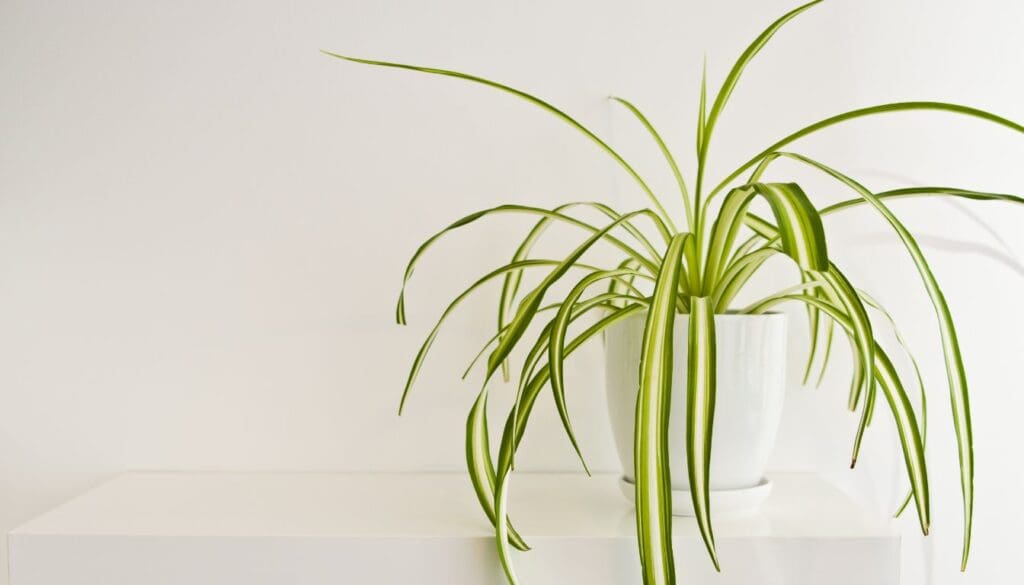
Please note: Simplify Plants is reader-supported. Some links in the post are affiliate links and I get a commission from purchases made through links in the post.
Spider plant winter care
Spider plants do not require much water during the winter and are medium plants. Unlike the succulents and the tender plants, the spider plants require watering almost every two weeks or so.
However, the spider plants need a little extra misting during the fall and winter.
It is right after the winter that we will notice the growth of the spider pups. The spider pups are crucial for the health of your spider plant. I will discuss the care requirements below, and we need to ensure that they do not develop any issues.
The things to worry about are:
- How much to Fertilize
- Placement of the Plant
- Watering your spider plant right
- Humidity and moisture
- Avoiding extremes
We will talk about the above situation in depth.
Fertilize your spider plant right
Spider plants are dormant during the winter season and do not show any growth signs. Thus, we need not add any feed during the winter season as the plant does not grow during winter.
However, we will need to fertilize the spider plant during the spring and summer seasons. Once in two weeks is fine during the growing season.
When we reach the fall, we reduce the feed by half, and during winter, we do not feed the plant at all.
As the plant is not absorbing any nutrients, the excess amount of fertilizer can make the soil acidic, and as a result, it will harm the plant. Thus, make sure you don’t feed the spider plant during winter.
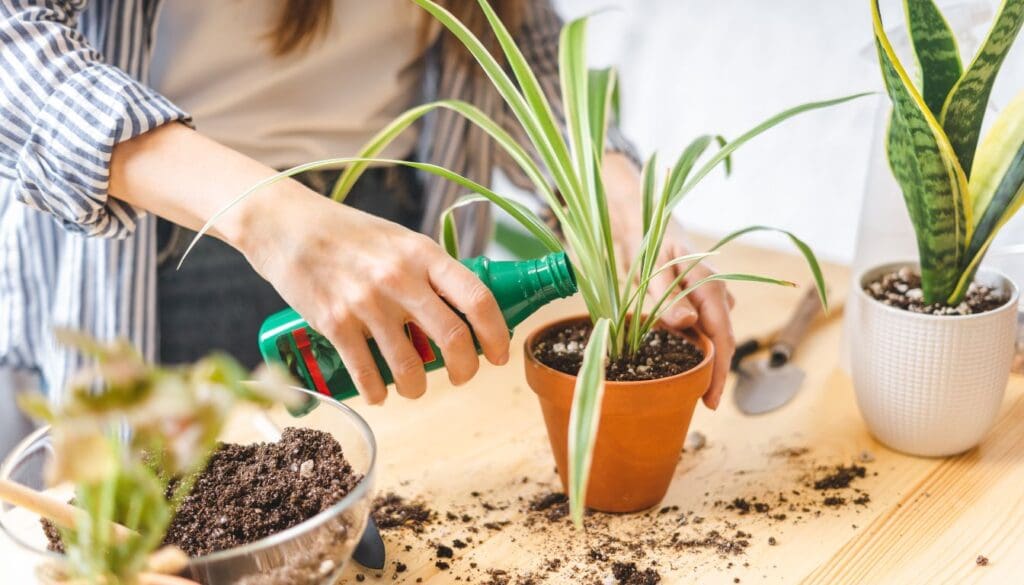
What type of feed is required for the spider plants?
The spider plant requires a very dilute dosage of feed. We should consider adding a 2-4-4 or a 4-4-4 all-purpose fertilizer for the spider plant.
A little compost does not harm, and it is an organic way to provide nutrients to the plants.
How to avoid overfertilization?
The steps to avoid overfertilization is are:
- Only fertilize during the growing season
- The feed should be a 2-4-4 or a 4-4-4 feed
- Remember, the spider plant requires only a dilute dosage
- We reduce the feed to half the amount during the late fall
- Never add fertilizer during the winter season
If we follow the above steps, we will reduce the risk of overfertilizing the spider plants.
However, what if the spider plant is already suffering from an overfertilization issue? Let us find out.
If the spider plant is already suffering from overfertilization, then:
- Remove the spider plant gently. Make sure you don’t hurt the roots of the plant
- We will need to keep the spider plant under running water
- This will ensure that the excess fertilizer is washed away
- Now, take a new pot of the same size as earlier
- Add well-draining potting soil along with a mixture of perlite/pumice and compost
- Mix the above ingredients and add to the new pot
- Next, place the root ball gently into the new pot
- Cover the plant with more soil and perlite mixture
- Give a gentle tap to the pot to remove the air pockets
- Water the plant
- Check for the drainage holes, whether excess water is going through it
- If blocked, clean the drainage hole
- Keep the plant in a place where it gets bright indirect sunlight
- Do not fertilize the plant for a month
All these steps help save an overfertilized spider plant, and we can avoid the overfertilization of any houseplants with the above steps.
Also read: Do spider plant need fertilizer? How much?
Look out for placement of the plant

The placement of the spider plant is of most importance. The spider plant requires bright indirect sunlight.
If we provide the plant with bright indirect sunlight for a few hours every day, we will notice that the spider plant’s leaves will develop better variegation.
We never suggest removing the plant from one extreme to another. If we move the plant from one extreme to another, then the spider plant will experience stunted growth.
It is suggested to keep the spider plant near a Northern window or even a west, or an east-facing window does the job.
The problem arises when the spider plant is placed in the Southern window, and the spider plant receives the cool draft during winters.
The spider plant will become droopy because of the cool draft, and the plant will wilt. We will also notice that the spider plant leaves have changed their color to yellow or brown.
The spider plant loves a temperature range from 70-90°F. However, the plant can tolerate temperatures as low as 35°F.
Avoid keeping the plant at such temperatures. We will need to provide the spider plant with proper light conditions.
The spider plant will require misting during the winter season and a heavy misting when we see the growth of the pups.
Another point to keep in mind for the spider plant is to keep it away from the children and your pets.
We can use hanging pots or spatial plantation to place the spider plants.
Artificial lights can also be preferred if the plant is kept in low light conditions.
Also read: Light requirement of spider plant and placement tips
Water your spider plant adequately
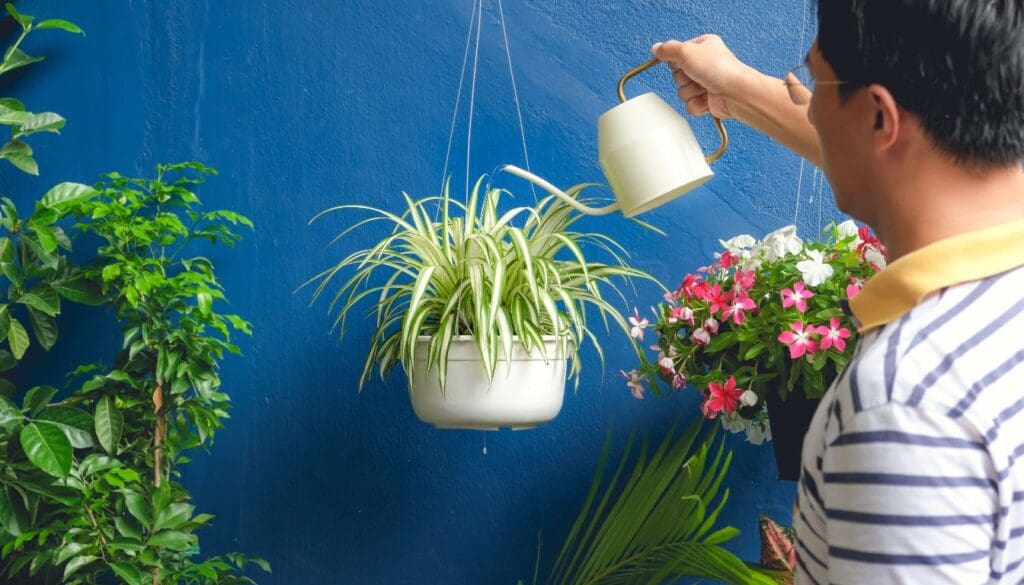
The watering condition is one thing that anyone can make a mistake.
It is mostly the overwatering of the spider plant during the winter that can really hurt your plant’s growth. It can even leave your plant wilting with no way to survive and bounce back in some conditions.
The spider plant needs watering every week during the summer, but around fall, we reduce the watering to half, and during winter, once every two weeks is sufficient.
It is always suggested to feel the soil before watering the spider plants. The soil should be dry and not moist.
Another point to consider is that we need to dig at least 2 inches deep to feel the soil. It could be that the top-soil is dry, but the soil inside is moist.
Generally, the spider plant is prone to overwatering during the winter. If the plant is left neglected, then the spider plant could attract pests as well.
How can we avoid overwatering?
The overwatering of any houseplant can be avoided by:
- Make a watering regime.
- We can certainly use digital calendars for watering.
- I suggest using sticky notes on the plant.
- Check for the drainage holes and clean them.
- Make sure that the plant does not stand on still water.
- Most important of all is to feel the soil before watering.
With the above steps, we can avoid the overwatering of any houseplant. It also ensures that the plant’s watering is right and as required by the plant.
However, what if the plant is already suffering from an overwatering situation?
If the plant is already suffering from an overwatering situation, then we might need to repot the plant in a new pot.
Let us check the steps and signs that will tell us when to repot the plant when suffering from an overwatering situation.
- Are you noticing the leaves getting yellow or brown?
- The plant might be droopy and wilting.
- All the above are signs of an overwatered plant.
- In this case, first, check the soil if it is moist.
- If the soil is exceptionally moist, then we will need a repot
- If the soil is not that moist, then we can just add well-draining soil
To repot the spider plant in a new pot:
- We will need a well-draining potting soil
- A mixture of perlite/pumice and compost
- A new pot
- Remove the spider plant with the root ball from the old pot
- Put the spider plant under running water
- Now, take the soil mixture and add it to the new pot
- Place the spider plant in the new pot
- Add the soil mixture
- Once filled, gently tap the pot to avoid any air-pockets
- Water the spider plant
- Check for the drainage holes and check if the excess water is removed
- Place the plant in indirect bright sunlight
- Do not fertilize the plant once newly repotted
Overwatering is a common mistake, and a mistake even experienced gardeners can make.
Never worry that you have overwatered your plant. With a little care and nurture, we can bring our plant back to life.
Also read: How much water do spider plant need?
Maintain adequate humidity and moisture

Spider plant loves that extra humidity and does not mind that extra misting.
Misting becomes more critical when we see the spider pups on the mother plant. At this time, the spider plant will need misting almost every day.
The best temperature requirement for the spider plant is 70-90°F. At this temperature, the spider plant thrives the best.
The spider plant can go as low as 35°F. It is never suggested to bring the plant to such low temperatures.
The spider plant loves bright indirect sunlight, and during winter, it becomes a little tricky. We need to close the windows from where the spider plant gets a cool draft.
Because of the cool draft, the spider plant may become droopy and develop a stunted growth.
It is always advised to keep the plant away from the radiators and the air-conditioning unit.
The heat from the radiators and the cool draft from the window reduces the moisture of the spider plant.
The spider plant’s leaves color changes to yellow and will fall off the plant to keep your spider plant thriving.
We need not reach that stage.
During winter, choose a place with high humidity like the washroom or an enclosed room. This will help the spider plant.
Also, misting can be helpful in certain situations. If the humidity level is really low, then we can also use a humidifier to help with the humidity.
If the plant does not receive the moisture it needs, then we might not see the spider pups grow.
An important point to note is to keep the Spider plant away from the radiators during winter.
Also read: Should I mist my spider plant?
Avoiding extremes for the plant
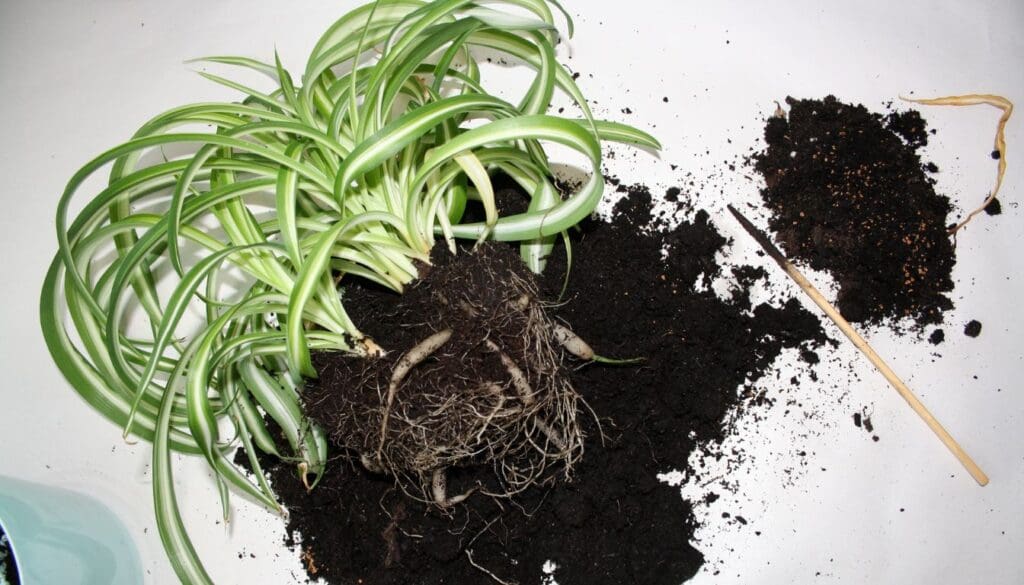
Some plant owners struggle to keep their spider plant alive. Even among them, one who changes the spider plant’s placement frequently is the one who struggles the most.
For instance, your spider plant was kept in your patio or somewhere outside throughout the summer, and you decide to bring them inside during the colder months, then keeping them alive can be a struggle for most of you.
What happens in such circumstances is that we moved the plant from one extreme to another, and as a result, the plant is in shock.
For example: When we keep our spider plant out on the patio, they get more bright light and longer duration. But as we move them inside, the plant gets less intensity and lower duration of sunlight. As a result, the plant is likely to suffer.
Another similar instance is when we move the spider plant from our bathroom to our living room. The plant was in a humid space, and when we move them to a dry environment, the plant is likely to get shocked.
Thus, we need to make sure we make the shift gradual. We can do this in two ways:
- Slowly letting the plant get acclimated to the new space for few hours daily for a few weeks before moving them permanently.
- Moving them to a similar environment where they were placed earlier.
If you do it right, your spider plant will not experience any problems.
However, if these things are not taken care of, then your plant is likely going to experience wilting of few leaves, stunted growth, and other problems as well.
Also read: How to revive a spider plant?

Source: Common insect pests and diseases, Spider Plants Introduction, Spider plant care, National science foundation.
Recommended Garden Supplies
| Product Image | Our Recommended Gardening Supplies | Check Offers! |
|---|---|---|
Top Top
Top
Top
Top
Top
Top
Top
Top | rePotme Houseplant and Tropical Classic Potting Soil Mix | Check Offer On Amazon |
 Top
Top
Top
Top
Top
Top
Top
Top | Espoma Organic Indoor Plant Food | Check Offer On Amazon |
 Top
Top
Top
Top
Top
Top
Top
Top | GooingTop LED Grow Light 6000K Full Spectrum Clip Plant Growing Lamp | Check Offer On Amazon |
 Top
Top
Top
Top
Top
Top
Top
Top | Soil Moisture Meter | Check Offer On Amazon |
 Top
Top
Top
Top
Top
Top
Top
Top | Govee Hygrometer Thermometer, Bluetooth Enabled! | Check Offer On Amazon |
 Top
Top | LEVOIT Humidifiers for Large Room(Best For Plants) | Check Offer On Amazon |
 Top
Top
Top
Top
Top
Top
Top
Top | Upgraded DIY Automatic Drip Irrigation Kit, 15 Potted Houseplants Support | Check Offer On Amazon |
 Top
Top
Top
Top
Top
Top
Top
Top | Stainless Steel Heavy Duty Gardening Tool Set | Check Offer On Amazon |
 Top
Top
Top
Top
Top
Top
Top
Top | Bonide Insecticidal Soap | Check Offer On Amazon |
 Top
Top
Top
Top
Top
Top
Top
Top | Bonide 32 oz Spray Neem Oil for Organic Gardening | Check Offer On Amazon |
 Top
Top
Top
Top
Top
Top
Top
Top | Garden Safe Fungicide | Check Offer On Amazon |


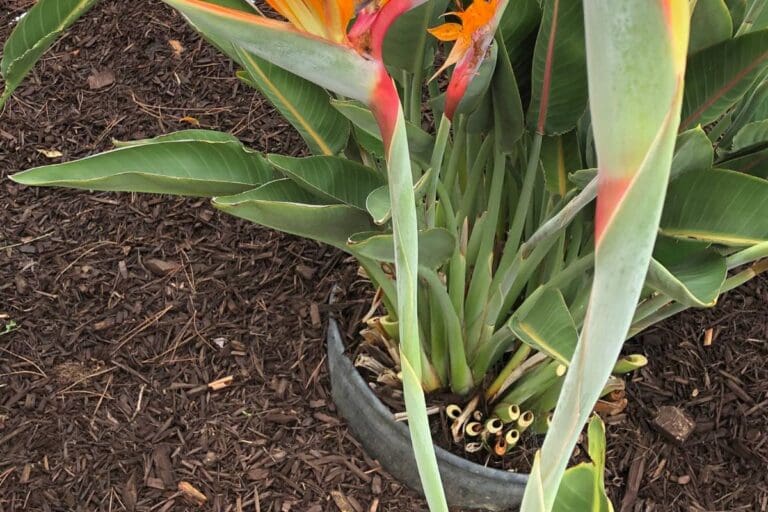


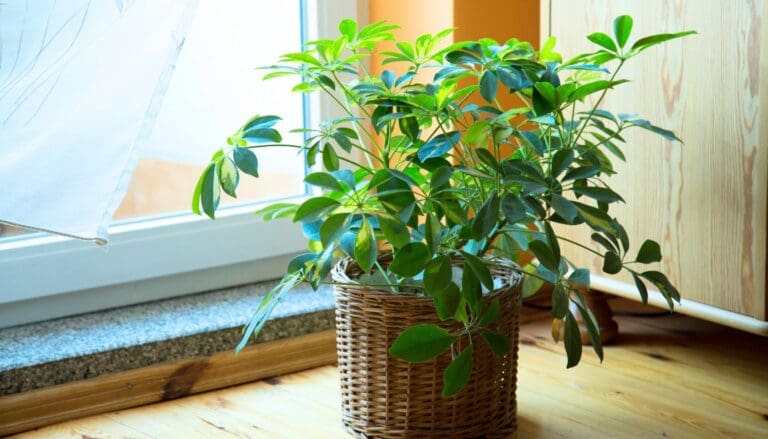
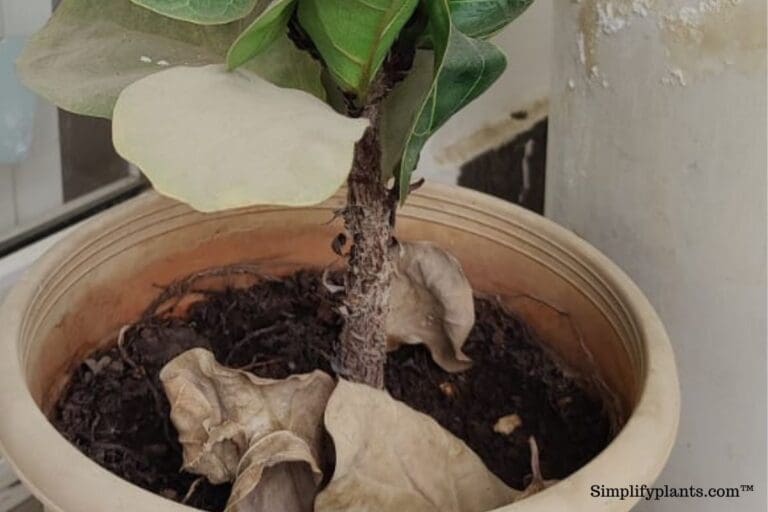
Great info here, thank you! I inherited my mom’s spider plant and it’s been in the same spot for 24 years. It’s medium sized, beautiful and produces healthy pups. She won’t get bigger unless I repot but then would have to be moved – I won’t disturb. Look forward to reading more.
Hey there!
It’s wonderful to hear about your cherished spider plant thriving for so many years! It’s impressive how well some plants can do in the same spot for so long. It sounds like it’s very happy where it is, and sometimes, if it ain’t broke, there’s no need to fix it. Keep doing what you’re doing, and it’ll keep rewarding you with those lovely pups. Can’t wait to share more with you – stay tuned for upcoming posts!
Happy plant-parenting! 🌱😊
Should I trim the pups off the plant before bringing the spider plant indoors for the winter?